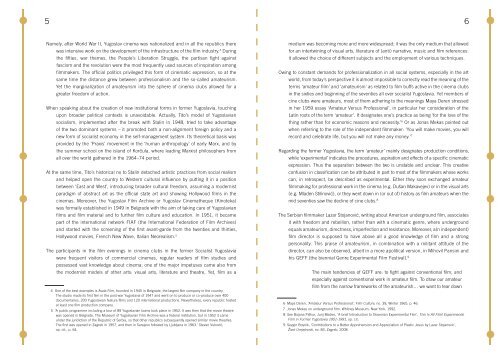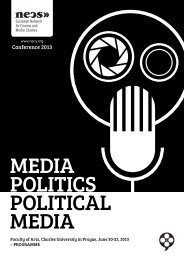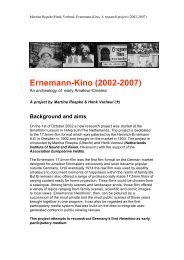Yugoslav experimental film and cine clubs in the sixties and seventies
Yugoslav experimental film and cine clubs in the sixties and seventies
Yugoslav experimental film and cine clubs in the sixties and seventies
You also want an ePaper? Increase the reach of your titles
YUMPU automatically turns print PDFs into web optimized ePapers that Google loves.
5 6<br />
Namely, after World War II, <strong>Yugoslav</strong> <strong>c<strong>in</strong>e</strong>ma was nationalized <strong>and</strong> <strong>in</strong> all <strong>the</strong> republics <strong>the</strong>re<br />
was <strong>in</strong>tensive work on <strong>the</strong> development of <strong>the</strong> <strong>in</strong>frastructure of <strong>the</strong> <strong>film</strong> <strong>in</strong>dustry. 4 Dur<strong>in</strong>g<br />
<strong>the</strong> fifties, war <strong>the</strong>mes, <strong>the</strong> People’s Liberation Struggle, <strong>the</strong> partisan fight aga<strong>in</strong>st<br />
fascism <strong>and</strong> <strong>the</strong> revolution were <strong>the</strong> most frequently used sources of <strong>in</strong>spiration among<br />
<strong>film</strong>makers. The official politics privileged this form of <strong>c<strong>in</strong>e</strong>matic expression, so at <strong>the</strong><br />
same time <strong>the</strong> distance grew between professionalism <strong>and</strong> <strong>the</strong> so-called amateurism.<br />
Yet <strong>the</strong> marg<strong>in</strong>alization of amateurism <strong>in</strong>to <strong>the</strong> sphere of <strong>c<strong>in</strong>e</strong>ma <strong>clubs</strong> allowed for a<br />
greater freedom of action.<br />
When speak<strong>in</strong>g about <strong>the</strong> creation of new <strong>in</strong>stitutional forms <strong>in</strong> former <strong>Yugoslav</strong>ia, touch<strong>in</strong>g<br />
upon broader political contexts is unavoidable. Actually, Tito’s model of <strong>Yugoslav</strong>ian<br />
socialism, implemented after <strong>the</strong> break with Stal<strong>in</strong> <strong>in</strong> 1948, tried to take advantage<br />
of <strong>the</strong> two dom<strong>in</strong>ant systems – it promoted both a non-alignment foreign policy <strong>and</strong> a<br />
new form of socialist economy <strong>in</strong> <strong>the</strong> self-management system. Its <strong>the</strong>oretical basis was<br />
provided by <strong>the</strong> ‘Praxis’ movement <strong>in</strong> <strong>the</strong> ‘human anthropology’ of early Marx, <strong>and</strong> by<br />
<strong>the</strong> summer school on <strong>the</strong> isl<strong>and</strong> of Korula, where lead<strong>in</strong>g Marxist philosophers from<br />
all over <strong>the</strong> world ga<strong>the</strong>red <strong>in</strong> <strong>the</strong> 1964–74 period.<br />
At <strong>the</strong> same time, Tito’s historical no to Stal<strong>in</strong> detached artistic practices from social realism<br />
<strong>and</strong> helped open <strong>the</strong> country to Western cultural <strong>in</strong>fluence by putt<strong>in</strong>g it <strong>in</strong> a position<br />
between ‘East <strong>and</strong> West’, <strong>in</strong>troduc<strong>in</strong>g broader cultural freedom, assum<strong>in</strong>g a modernist<br />
paradigm of abstract art as <strong>the</strong> official state art <strong>and</strong> show<strong>in</strong>g Hollywood <strong>film</strong>s <strong>in</strong> <strong>the</strong><br />
<strong>c<strong>in</strong>e</strong>mas. Moreover, <strong>the</strong> <strong>Yugoslav</strong> Film Archive or <strong>Yugoslav</strong> C<strong>in</strong>ema<strong>the</strong>que (K<strong>in</strong>oteka)<br />
was formally established <strong>in</strong> 1949 <strong>in</strong> Belgrade with <strong>the</strong> aim of tak<strong>in</strong>g care of <strong>Yugoslav</strong>ian<br />
<strong>film</strong>s <strong>and</strong> <strong>film</strong> material <strong>and</strong> to fur<strong>the</strong>r <strong>film</strong> culture <strong>and</strong> education. In 1951, it became<br />
part of <strong>the</strong> <strong>in</strong>ternational network FIAF (<strong>the</strong> International Federation of Film Archives)<br />
<strong>and</strong> started with <strong>the</strong> screen<strong>in</strong>g of <strong>the</strong> first avant-garde from <strong>the</strong> twenties <strong>and</strong> thirties,<br />
Hollywood movies, French New Wave, Italian Neorealism. 5<br />
The participants <strong>in</strong> <strong>the</strong> <strong>film</strong> even<strong>in</strong>gs <strong>in</strong> <strong>c<strong>in</strong>e</strong>ma <strong>clubs</strong> <strong>in</strong> <strong>the</strong> former Socialist <strong>Yugoslav</strong>ia<br />
were frequent visitors of commercial <strong>c<strong>in</strong>e</strong>mas, regular readers of <strong>film</strong> studies <strong>and</strong><br />
possessed vast knowledge about <strong>c<strong>in</strong>e</strong>ma; one of <strong>the</strong> major impetuses came also from<br />
<strong>the</strong> modernist models of o<strong>the</strong>r arts: visual arts, literature <strong>and</strong> <strong>the</strong>atre, Yet, <strong>film</strong> as a<br />
4 One of <strong>the</strong> best examples is Avala Film, founded <strong>in</strong> 1945 <strong>in</strong> Belgrade, <strong>the</strong> largest <strong>film</strong> company <strong>in</strong> <strong>the</strong> country.<br />
The studio made its first <strong>film</strong> <strong>in</strong> <strong>the</strong> post-war <strong>Yugoslav</strong>ia of 1947 <strong>and</strong> went on to produce or co-produce over 400<br />
documentaries, 200 <strong>Yugoslav</strong>ian feature <strong>film</strong>s <strong>and</strong> 120 <strong>in</strong>ternational productions. Never<strong>the</strong>less, every republic hosted<br />
at least one <strong>film</strong> production company.<br />
5 ‘A public programme <strong>in</strong>clud<strong>in</strong>g a tour of 89 <strong>Yugoslav</strong>ian towns took place <strong>in</strong> 1952. It was <strong>the</strong>n that <strong>the</strong> movie <strong>the</strong>atre<br />
was opened <strong>in</strong> Belgrade. The Museum of <strong>Yugoslav</strong>ian Film Archive was a federal <strong>in</strong>stitution, but <strong>in</strong> 1952 it came<br />
under <strong>the</strong> juridiction of <strong>the</strong> Republic of Serbia, so that o<strong>the</strong>r republics subsequently opened similar movie <strong>the</strong>atres.<br />
The first was opened <strong>in</strong> Zagreb <strong>in</strong> 1957, <strong>and</strong> <strong>the</strong>n <strong>in</strong> Sarajevo followed by Ljubljana <strong>in</strong> 1963.’ Stevan Vukovi,<br />
op. cit., p. 64.<br />
medium was becom<strong>in</strong>g more <strong>and</strong> more widespread; it was <strong>the</strong> only medium that allowed<br />
for an <strong>in</strong>tertw<strong>in</strong><strong>in</strong>g of visual arts, literature of (anti) narrative, music <strong>and</strong> <strong>film</strong> references:<br />
it allowed <strong>the</strong> choice of different subjects <strong>and</strong> <strong>the</strong> employment of various techniques.<br />
Ow<strong>in</strong>g to constant dem<strong>and</strong>s for professionalization <strong>in</strong> all social systems, especially <strong>in</strong> <strong>the</strong> art<br />
world, from today’s perspective it is almost impossible to correctly read <strong>the</strong> mean<strong>in</strong>g of <strong>the</strong><br />
terms ‘amateur <strong>film</strong>’ <strong>and</strong> ‘amateurism’ as related to <strong>film</strong> buffs active <strong>in</strong> <strong>the</strong> <strong>c<strong>in</strong>e</strong>ma <strong>clubs</strong><br />
<strong>in</strong> <strong>the</strong> <strong>sixties</strong> <strong>and</strong> beg<strong>in</strong>n<strong>in</strong>g of <strong>the</strong> <strong>seventies</strong> all over socialist <strong>Yugoslav</strong>ia. Yet members of<br />
<strong>c<strong>in</strong>e</strong> <strong>clubs</strong> were amateurs, most of <strong>the</strong>m adher<strong>in</strong>g to <strong>the</strong> mean<strong>in</strong>gs Maya Deren stressed<br />
<strong>in</strong> her 1959 essay ‘Amateur Versus Professional’, <strong>in</strong> particular her consideration of <strong>the</strong><br />
Lat<strong>in</strong> roots of <strong>the</strong> term ‘amateur’. It designates one’s practice as be<strong>in</strong>g ‘for <strong>the</strong> love of <strong>the</strong><br />
th<strong>in</strong>g ra<strong>the</strong>r than for economic reasons <strong>and</strong> necessity.’ 6 Or as Jonas Mekas po<strong>in</strong>ted out<br />
when referr<strong>in</strong>g to <strong>the</strong> role of <strong>the</strong> <strong>in</strong>dependent <strong>film</strong>maker: ‘You will make movies, you will<br />
record <strong>and</strong> celebrate life, but you will not make any money.’ 7<br />
Regard<strong>in</strong>g <strong>the</strong> former <strong>Yugoslav</strong>ia, <strong>the</strong> term ‘amateur’ ma<strong>in</strong>ly designates production conditions,<br />
while ‘<strong>experimental</strong>’ <strong>in</strong>dicates <strong>the</strong> procedures, aspiration <strong>and</strong> effects of a specific <strong>c<strong>in</strong>e</strong>matic<br />
expression. Thus <strong>the</strong> separation between <strong>the</strong> two is unstable <strong>and</strong> unclear. This creative<br />
confusion <strong>in</strong> classification can be attributed <strong>in</strong> part to most of <strong>the</strong> <strong>film</strong>makers whose works<br />
can, <strong>in</strong> retrospect, be described as <strong>experimental</strong>. Ei<strong>the</strong>r <strong>the</strong>y soon exchanged amateur<br />
<strong>film</strong>mak<strong>in</strong>g for professional work <strong>in</strong> <strong>the</strong> <strong>c<strong>in</strong>e</strong>ma (e.g. Dušan Makavejev) or <strong>in</strong> <strong>the</strong> visual arts<br />
(e.g. Mladen Stil<strong>in</strong>ovi), or <strong>the</strong>y went down <strong>in</strong> (or out of) history as <strong>film</strong> amateurs when <strong>the</strong><br />
mid <strong>seventies</strong> saw <strong>the</strong> decl<strong>in</strong>e of <strong>c<strong>in</strong>e</strong> <strong>clubs</strong>. 8<br />
The Serbian <strong>film</strong>maker Lazar Stojanovi, writ<strong>in</strong>g about American underground <strong>film</strong>, associates<br />
it with freedom <strong>and</strong> rebellion, ra<strong>the</strong>r than with a <strong>c<strong>in</strong>e</strong>matic genre, where underground<br />
equals amateurism, directness, imperfection <strong>and</strong> resistance. Moreover, a(n <strong>in</strong>dependent)<br />
<strong>film</strong> director is supposed to have above all a good knowledge of <strong>film</strong> <strong>and</strong> a strong<br />
personality. This praise of amateurism, <strong>in</strong> comb<strong>in</strong>ation with a militant attitude of <strong>the</strong><br />
director, can also be observed, albeit <strong>in</strong> a more apolitical version, <strong>in</strong> Mihovil Pans<strong>in</strong>i <strong>and</strong><br />
his GEFF (<strong>the</strong> biennial Genre Experimental Film Festival). 9<br />
The ma<strong>in</strong> tendencies of GEFF are: to fight aga<strong>in</strong>st conventional <strong>film</strong>, <strong>and</strong><br />
especially aga<strong>in</strong>st conventional work <strong>in</strong> amateur <strong>film</strong>. To draw our amateur<br />
<strong>film</strong> from <strong>the</strong> narrow frameworks of <strong>the</strong> amateurish… we want to tear down<br />
6 Maya Deren, ‘Amateur Versus Professional’, Film Culture, no. 39, W<strong>in</strong>ter 1965, p. 46.<br />
7 Jonas Mekas on underground <strong>film</strong>, Whitney Museum, New York, 1992.<br />
8 See Bojana Piškur, Jurij Meden, ‘A brief Introduction to Slovenian Experimental Film’, This Is All Film! Experimental<br />
Film <strong>in</strong> Former <strong>Yugoslav</strong>ia 1951-1991, op. cit.<br />
9 Sezg<strong>in</strong> Boynik, ‘Contributions to a Better Apprehension <strong>and</strong> Appreciation of Plastic Jesus by Lazar Stojanovic’,<br />
Život Umjetnosti, no. 83, Zagreb, 2008.





